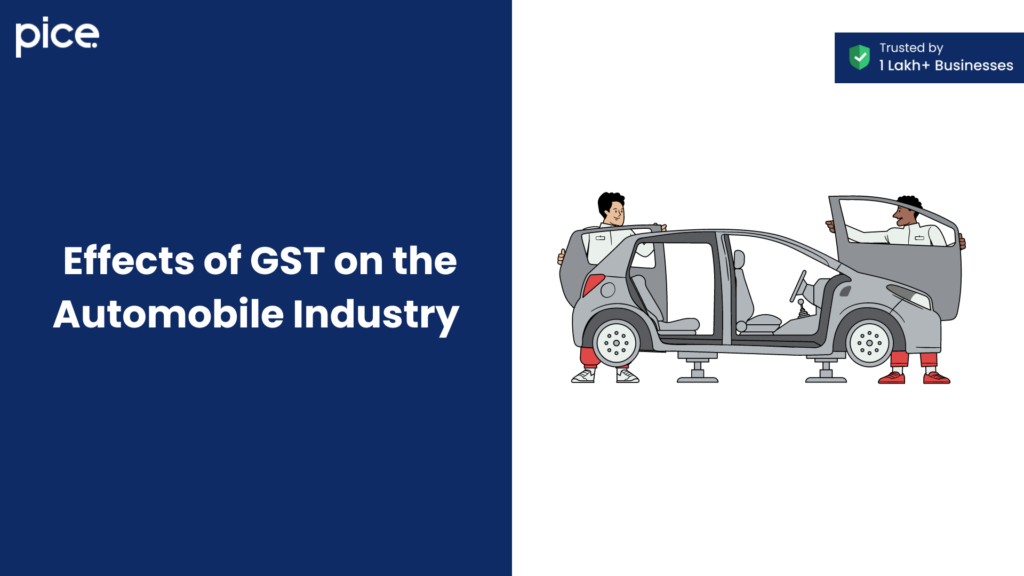GST’s Impact on Car Prices and Other Automobiles in India
- 20 Sep 24
- 10 mins

GST’s Impact on Car Prices and Other Automobiles in India
- Pre-GST Tax Structure on Automobiles
- GST Rates on Cars in India
- GST on Cars by Category
- GST on Cars by Fuel Type
- Effects of GST on the Automobile Industry
- Impact on Consumers
- Impact on Manufacturers
- Impact on Dealers and Importers
- Calculating GST on Cars
- GST Exemptions for Cars
- Is Now a Good Time to Buy a Car?
- The Bottom Line
Key Takeaways
- GST replaced multiple indirect taxes, simplifying the tax structure for automobiles.
- The GST regime reduced manufacturing and operating costs, benefiting vehicle manufacturers.
- Consumers experienced a reduced tax burden, leading to lower vehicle prices.
- The luxury car and SUV market saw a decline due to high additional cess rates.
- Electric vehicles and ambulances enjoy lower GST rates to encourage environmental and healthcare benefits.
The Goods and Services Tax (GST) simplified the taxation system in more ways than one. Unlike the erstwhile regime that involved multiple indirect taxes at various stages, GST subsumed all those taxes under one centralised tax.
The automobile industry of India produces a huge number of vehicles yearly which brings along a tedious taxation burden on the companies. GST helped reduce the burden on automobile manufacturing companies by providing an alternative universal tax system.
In this blog, we will discuss the pre and post-GST tax structure on automobiles, the impact of GST on the automobile sector and many more.
Pre-GST Tax Structure on Automobiles
The following table shows the tax structure on automobiles in India before the GST regime:
| Segment | Excise | Nccd + auto cess | VAT | Road tax | Motor vehicle tax | Total |
| Small cars <1200cc | 12.50% | 1.1% | 14% | Varies from state to state | Varies from state to state | Approximately 28% |
| Mid-sized cars (1200cc-1500cc) | 24% | 1.1% | 14% | Varies from state to state | Varies from state to state | 39% |
| Luxury cars >1500cc | 27% | 1.1% | 14% | Varies from state to state | Varies from state to state | 42% |
| SUV’s >1500cc, >170mm ground clearance | 30% | 1.1% | 14% | Varies from state to state | Varies from state to state | 45% |
In the pre-GST tax regime, VAT was imposed upon used car sales. There was no composite rate and Excise/VAT was not charged against advance received for goods supply in some states. States had various incentive schemes for the Original Equipment Manufacturers (OEMs).
💡If you want to pay your GST with Credit Card, then download Pice Business Payment App. Pice is the one stop app for all paying all your business expenses.
This scheme primarily included subsidies and interest-free loans. VAT was also levied on sales. Goods or services sold without consideration were free of VAT or service tax.
Dealers or importers were not eligible for CVD and excise duty paid by the Original Equipment Manufacturers (OEMs). Excise duty was applicable when goods were transported from the factory. However, VAT/CST was not applicable under the previous tax laws.
GST Rates on Cars in India
Since GST became effective on July 1st, 2017, its objective has been to smoothen the tax process. It reduces the burden of tax, catalysing transparency in the automobile industry. Depending upon the type, GST rates on vehicles may vary. The GST Council declares the rates and it includes additional cess on SUVs and luxury cars.
GST has significantly simplified the tax structure by subsuming multiple taxes into one universal tax. It, therefore, has also cut down the selling prices of vehicles for consumers besides making it easier for the Indian government to collect tax.
GST on Cars by Category
The following table illustrates the GST rates for various types of cars concerning price, size and engine capacity:
| Type of Vehicle | GST Rate | Additional Cess | Total Tax Rate |
| Small cars <1200cc <4m length | 28% | 1-3% | 29-31% |
| Mid-sized cars >4m length | 28% | 15% | 43% |
| Luxury cars >1500cc, >4m length | 28% | 20% | 48% |
| SUVs >1500cc, >4m length, >170m ground clearance | 28% | 22% | 50% |
| Electric vehicles | 5% | Nil | 5% |
| Ambulances | 12% | Nil | 12% |
| Hybrid cars | 28% | 15% | 43% |
| Refrigerated Motor Vehicle | 18% | Nil | 18% |
GST on Cars by Fuel Type
The GST rates on vehicles vary depending on the type of fuel they use. Read the table below to understand the various rates of GST on vehicles running on different types of fuels:
| Type of Vehicle | GST Rate | Additional Cess | Total Tax Rate |
| Petroleum gas/CNG/LPG cars <1200cc <4m length | 28% | 1% | 29% |
| Petrol/CNG/LPG cars <1200cc >4m length | 28% | 15% | 43% |
| Petrol/CNG/LPG cars >1200cc | 28% | 22% | 50% |
| Diesel cars <1500c <4m length | 28% | 3% | 31% |
| Diesel cars <1500cc >4m length | 28% | 20% | 48% |
| Diesel cars >1500cc >4m length >170m ground clearance | 28% | 22% | 50% |
| Motorcycles <350cc | 28% | 0% | 28% |
| Motorcycles >350cc | 28% | 3% | 31% |
| Three-wheeler motor vehicles | 28% | 0% | 28% |
| Fuel cell vehicles | 12% | 0% | 12% |
Effects of GST on the Automobile Industry

Automotive industry witnessed a positive GST impact. The commercial vehicle segment has witnessed a significant reduction in tax rate under GST, as compared to the pre-GST era. It is now 28% instead of 30-33%. Most aspects of the GST regime focus more on consumption than origin. This has opened doors to significant growth for the vehicle sector.
However, GST has impacted less on non-commercial vehicles. Luxury cars and SUV sales have dropped due to high additional cess rates. Transfer of vehicle ownership has applicable GST, irrespective of intra-state or interstate sales.
The GST system not only offers benefits to manufacturers but also to consumers and dealers or importers. Read on to know how at each stage GST facilitates higher consumption of vehicles.
Impact on Consumers
In the pre-GST scenario, two taxes were levied. One of them was excise and the other one was VAT. The combined rate of the two taxes put together was 26.5% to 44%. The GST tax rate applicable is 18% and 28% is much lower than that. Therefore, consumers have less of a consumer tax burden under the GST regime. This also helps to reduce the cascading effect of taxation.
Impact on Manufacturers
The GST system consolidates all previous taxes under one tax. This brings down the manufacturing cost of vehicles by a wide margin. This has led to more production under GST.
The improved supply chain mechanism under GST is highly efficient. The discard of state-level taxes has made transportation from one state to another easier. This has also reduced the time taken for transit and costs. This in turn leads to cheaper operating costs for manufacturers.
Impact on Dealers and Importers
Dealers and importers can claim GST paid on goods that are sold or imported. That helps them too as previously, they were unable to claim excise duty and VAT paid. According to the previous tax laws, importers or dealers were not eligible to claim the tax paid on such goods.
The GST system also lets importers and dealers claim input credit mechanisms, unlike the previous tax laws. Under GST, the excise paid on stock transfer is covered by IGST. On the other hand, the advance for supplying goods is liable to tax payment too as per GST rules.
Calculating GST on Cars
The GST calculation for cars requires a proper understanding of the GST rate along with any additional cess applicable. These rates vary depending on the type of vehicle. The formula for calculating tax on automobiles goes as follows:
Total Tax = Ex-showroom Price × (GST Rate + Cess Rate)
GST Exemptions for Cars
Although most categories of vehicles are subject to GST, there are particular exemptions and concession rates for some vehicles.
Electric cars are taxed at a lower rate of 5% compared to other fuel vehicles. This initiative promotes the consumption of environment-friendly automobiles.
The GST rate on ambulance vehicles is 12%. This low rate has been declared keeping in mind their contribution to the medical services they offer. It ensures easy access to ambulances for healthcare service providers at a cheaper purchase price. Thus, this exemption facilitates smoothed medical transportation.
Vehicles used by handicapped persons, such as wheelchairs, are also eligible for exemption from GST. There are certain criteria set by the government. If they meet those conditions, they can apply for exemptions. The initiative aims towards the betterment of the lives of those who are physically disabled in any way.
The government also offers an exemption of GST on purchasing a used car from an unregistered dealer.
Is Now a Good Time to Buy a Car?
According to experts, the prices of mid-segment vehicles might see a rise. On the other hand, small diesel-powered vehicles are likely to be affected the most. Individuals can expect an increment in the prices of the same.
Luxury SUVs, meanwhile, are said to be coming up with exciting offers. They will reduce the buying prices of their brands a lot compared to their usual prices.
The Bottom Line
The impact of GST on the automobile sector is an interplay of market dynamics, regulatory changes and consumer behaviour. It has brought greater transparency and uniformity of vehicle prices across the country. Consumers now find it easier to understand the taxable component of vehicles while automobile industries witnessed a greater distribution network.
 By
By 


















